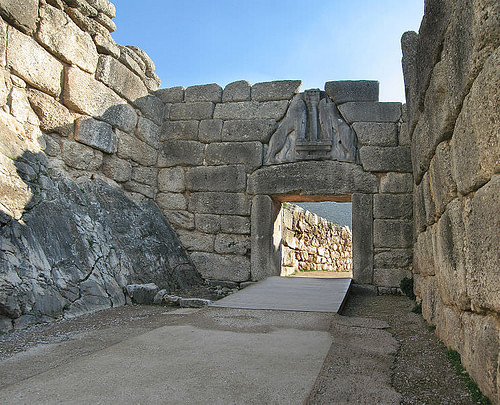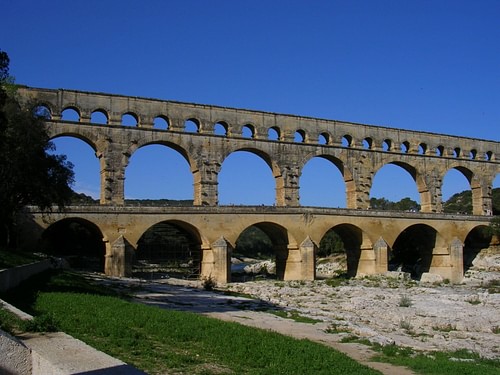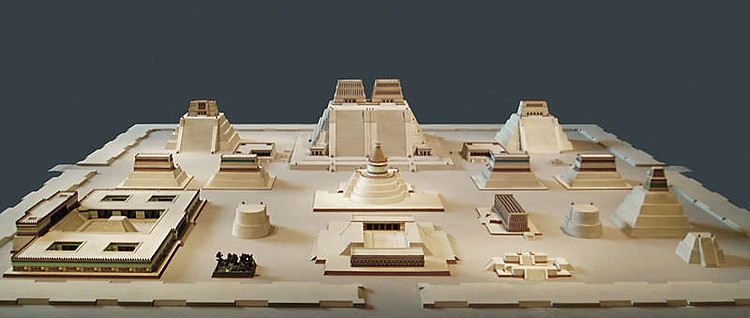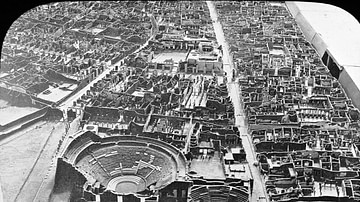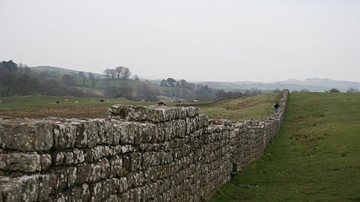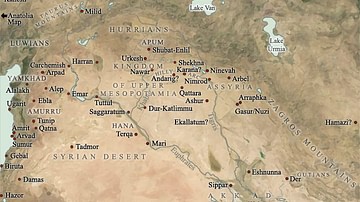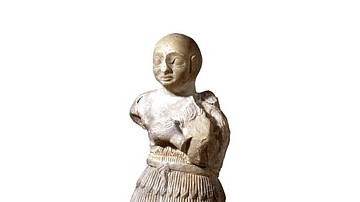
In the study of the ancient world a City is generally defined as a large populated urban center of commerce and administration with a system of laws and, usually, regulated means of sanitation. This is only one definition, however, and the designation `City' can be based on such factors as the:
- population of the settlement
- height of buildings
- density of buildings/population
- presence of some kind of sewer system
- level of administrative government
- presence of walls and/or fortifications
- geographical area of the settlement
- or whether a `settlement' was called a `city' in antiquity and fits at least one of the above qualifications.
In the ancient world, very often a `city' describes an urban center of dense population and a certain pattern of buildings spreading out from a central religious complex such as a temple (though, frustratingly, this could sometimes apply equally well to a `village' or `settlement'). The word `city' derives from the Latin civitas although urban development pre-dates Rome by many centuries. Professor M. E. Smith of Arizona State University writes in The Sage Encyclopedia of Urban Studies, that, "The demographic definition, based on the concepts of Louis Wirth, identifies cities as large, dense settlements with social heterogeneity" (26), meaning that they are defined as large communities of people who have decided to live together for a common purpose under laws observed by all. This definition, however, could apply equally well to large villages as to cities.
Professor George Modelski, of the University of Washington, encourages a definition based on the work of the historian Tertius Chandler (in his book Four Thousand Years of Urban Growth) which defines a city, as distinct from a village, based upon population. Modelski writes:
Two elements go into a population estimate: the archaeologists' site assessment (be it the area of urban settlement in general, or an estimate, or actual count, of houses), and a population density factor, be it `macro' for the entire urban site, or `micro', per house ratio…The micro-estimate requires a reliable house count, and that is not really available for most of the sites. On the other hand, a macro-factor is liable to error, such as ignoring local conditions (3).
Despite the problems inherent in these estimates, Modelski claims, they are still the best way in which to differentiate a large settlement from an actual city because population density is considered the most reliable factor in making such a determination. Adopting Chandler's means of definition, then, settlements such as Tell Brak in modern-day Syria (first founded in c. 6000 BCE) cannot be considered cities. Professor Smith writes:
The concept of the `urban revolution', first identified by V. Gordon Childe (1892-1957 CE), describes a series of social changes that brought about the development of the earliest cities and states… These changes (such as the origin of social classes and the production of an agricultural surplus) provided the social context for the earliest cities. Once class-structured state societies took hold in a region, individual cities rose and fell in response to a variety of forces (26).
The First City
The first cities which fit both Chandler's and Wirth's definitions of a `city' (and, also the early work of the archaeologist Childe) developed in the region known as Mesopotamia between 4500 and 3100 BCE. The city of Uruk, today considered the oldest in the world, was first settled in c. 4500 BCE and walled cities, for defence, were common by 2900 BCE throughout the region. The city of Eridu, close to Uruk, was considered the first city in the world by the Sumerians while other cities which lay claim to the title of `first city' are Byblos, Jericho, Damascus, Aleppo, Jerusalem, Sidon, Luoyang, Athens, Argos, and Varasani. All of these cities are certainly ancient and are located in regions which have been populated from a very early date. Uruk, however, is the only contender for the title of `oldest city' which has physical evidence and written documentation, in the form of cuneiform texts, dating the activities of the community from the earliest period. Sites such as Jericho, Sidon, and even Eridu, which were no doubt settled before Uruk, lack the same sort of documentation. Their age and continuity of habitation has been gauged based upon the foundations of buildings unearthed in archaeological excavations rather than primary documents found on site.
Population in Ancient Cities
The population of ancient cities, depending upon which definition of `city' one uses, differed sharply from what one might consider proper for a city in the modern day. Professor Smith claims, “Many ancient cities had only modest populations, often under 5,000 persons” (26) while other scholars, such as Modelski, cite higher population possibilities in the range of 10,000 to 80,000 depending upon the period under consideration. Modelski, for example, cites the population of Uruk at 14,000 in the year 3700 BCE but 80,000 by the year 2800 BCE (12). By comparison, the population of the city of Edinburgh, Scotland was 495,360 in 2011 CE, the population of London, England 8.174 million in 2011 CE, and the population of New York City in the United States of America was 8.337 million in 2012 CE. The historian Lewis Mumford, however, notes that, “Probably no city in antiquity had a population of much more than a million inhabitants, not even Rome; and, except for China, there were no later `Romes' until the nineteenth century” (6). Mumford's point highlights the problem of using population as a means of defining an ancient city as it has been proven that urban centers designated `settlements' (such as Tell Brak) had larger populations than many modern cities in the present day. The gathering of the populace of a region into an urban center became more and more common following the rise of the cities in Mesopotamia and, once enclosed within the walls of a city, population increased or, at least, such an increase became more measurable.
Population increase led to suburbanization and the spread of the settlement beyond the original boundaries. Modern scholars are then faced with the further problem in defining a city in that some claim suburban expanse should not be considered while others insist that it must be. This problem is most clearly seen, as are so many others regarding the definition of a city, in the example of Tell Brak. While the original settlement may have been smaller than Uruk, the size had grown by the 2nd millennium BCE to over 320 acres (130 hectares) and, since it was founded earlier, argues for its claim as the oldest city in the world. Its population would have been considerably larger than that of modern-day Edinburgh, to choose one example, and so it should be designated a city based on population; the fact that it is not considered a city by so many experts in the field exemplifies the modern scholarly debate on defining ancient urban centers as `cities' or `settlements'. This debate also includes whether a settlement needs to have had a wall around it in order to truly be called a `city'.
The Walled City
Walled cities were common throughout Mesopotamia. The most famous and, today, probably the most controversial, city in the ancient world was Babylon. It remains controversial for the same reason as its fame in that the city is featured prominently – and negatively – in so many of the biblical narratives. Far from being a 'city of evil', however, Babylon was a great and prosperous cultural and intellectual centre, being the first, among other achievements, to perfect the art of glass making c. 1500 BCE as well as further developing the arts and sciences known today as astronomy, astrology, early physics, mathematics, law, literature, architecture, and sculpture. The great king Hammurabi first encircled Babylon with walls in 1792 BCE and built the first sacred temple complex to the god Marduk (the Esagila) including the ziggurat, a high stepped tower (which may have given rise to the famous biblical account of the Tower of Babel) all centered around the river Euphrates. Babylon reached its height, however, under the reign of Nebuchadnezzar II (who lived 634-562 BCE, reigning from 605-562 BCE) who ringed the city three times around with walls 40 feet high and so thick that chariot races were held atop them. The walls of Babylon, and especially the great Ishtar Gate, appeared on some writer's lists among the Seven Wonders of the Ancient World and were considered a marvel, encircling the city for ten miles.
Mesopotamian, and later Greek and Roman cities, were characterized by their walls and this held true of other civilizations as well. The walls of the city known as the Great Zimbabwe (in modern-day Zimbabwe) defined it and those of the city of Benin (in modern-day Nigeria) were equally considered a hallmark of that site. It is unlikely that Mesopotamia influenced these other cultures directly and it seems more probable that walls were erected throughout the world without the influence of cultural transmission and simply as a natural response to the possibility of attack by neighboring cities and the uncertainties of the natural world. In China, the tradition continued of raising walls around a city (except, notably, at Angyang, which was never walled). Even so, there were cultures which constructed cities without walls or, at least, without ramparts of any great height or length. The cities of the Maya of Mesoamerica had no significant walls (though they did have gates) and the Egyptians seem to have dispensed with the concept of the walled city entirely. Smith writes:
Because archaeologists have failed to find large cities in Egypt prior to Akhenaten's capital at Amarna in the New Kingdom period (1350 BCE), Egypt has sometimes been contrasted to Mesopotamia as a `civilization without cities'. This label masks a distinctive form of urbanism, however. While it is possible that flooding by the Nile River destroyed earlier large capitals, it appears more likely that the Egyptians forged a form of dispersed urbanism characterized by smaller, more specialized urban settlements (25).
Walled cities were the centres of life for the ancient Mesopotamians, however, and the population of Babylon (200,000 during the reign of Nebuchadnezzar II) did not differ from the other city-states in their reliance on the walls of the city to separate them from the uncertainty and danger of the outside world. Beyond the walls of the city stretched the long fields for cultivation and the grazing of cattle but also lurked the uncontrollable aspects of nature and the enmity of those hostile to one's city. Although a significant percentage of the populace left the confines of the city every day to tend fields and cattle and engage in trade, the lives of the people unfolded primarily behind the city walls. So important was the concept of the city to the people of Mesopotamia that they held the city of Eridu to be the birthplace of humanity instead of a garden such as the Eden of the biblical Book of Genesis.
The Benefits & Cost of the City
No scholarly consensus exists on why urbanization began in Mesopotamia and speculation ranges from the lack of rainfall in the region, to environmental factors such as the long, open plains which left inhabitants at the mercy of the elements (and, in time, invaders) without walled cities, to the simple explanation that prosperous villages attracted more people and grew steadily into urban centers. Lewis Mumford suggests that:
Physical security and social continuity were the two great contributions for the city. Under those conditions every kind of conflict and challenge became possible without disrupting the social order…Through its storage, canalization, and irrigation, the city, from its earliest emergence in the Near East, justified its existence, for it freed the community from the caprices and violences of nature – though no little part of that gift was nullified by the further effect of subjecting the community more abjectly to the caprices and violences of men (5).
This separation of human beings from their natural environment produced an artificial world in which people no longer had to concern themselves with the cycles of nature in order to survive. Rain water could be stored for later use, as could the harvested crops, and fields could be irrigated by human ingenuity instead of reliance on the gods to send the rain. As cities grew in size, they also grew in power and, as Smith notes, “Rulers used urban architecture to communicate messages about power, wealth, legitimacy, and other ideological themes” (27). The old system of rural living, in which human communities were dependent on a relationship with the land, changed with the rise of urban centers; now humans controlled the natural environment and bent the surrounding land to their will. Mumford notes that, “under the protective mantle of the city, seemingly so permanent, these illusions encouraged habits of predation and parasitism that eventually undermined the whole social and economic structure, after having worked ruin in the surrounding landscape and even in far-distant regions. Many elements supplied by nature, necessary for both health and mental balance, were lacking in the city” (6).
This is not to say, however, that the city, and the urbanization process, had no long-term benefits. The historian Paul Kriwaczek writes:
With the city came the centralized state, the hierarchy of social classes, the division of labour, organized religion, monumental building, civil engineering, writing, literature, sculpture, art, music, education, mathematics and law, not to mention a vast array of new inventions and discoveries, from items as basic as wheeled vehicles and sailing boats to the potter's kiln, metallurgy and the creation of synthetic materials. And on top of all that was the huge collection of notions and ideas so fundamental to our way of looking at the world, like the concept of numbers, or weight, quite independent of actual items counted or weighed – the number ten, or one kilo – that we have long forgotten that they had to be discovered or invented (20-21).
Even so, the artificial nature of the urban environment is the reason why so many ancient cities, not destroyed in conquest, were destroyed by their inhabitants or abandoned. All of the great Mayan urban centres were deserted before 900 CE and many of the most important Mesopotamian cities, like Uruk and Eridu, were emptied long before then. Over-population and a depletion of resources led to the decline of many ancient cities and Mumford claims that this occurs with urban centres “when a city is no longer in symbiotic relationship with its surrounding land; when further growth overtaxes local resources, like water, and makes them precarious; when in order to continue its growth, a city must reach beyond its immediate limits for water, for fuel, for building material” (6). This is exactly what happened to the Maya city of Copan and to many others throughout the ancient world. In Copan, and many other Maya centers, the lack of water to supply the population increasingly became a serious problem.
This same paradigm, whether a lack of water or other resources, led to the downfall of other great cities in other countries throughout the ancient world and still obtains in the modern day. In the region which once gave rise to the first cities, the Fertile Crescent is presently far from fertile. David Michael, of Stimson Global Security, writes, “Growing populations, soaring demand, mounting environmental pressures, and potentially unsustainable development programs risk imposing untenable burdens on the region's freshwater resources.” This situation, recognizable in the past, is a threat to the environment in the present day. Human beings created artificial environments, cities, in order to keep them safe and allow them a semblance of control over life and, in doing so, distanced themselves from the natural environment they needed in order to survive so that, in the case of many ancient cities, neither environment was sustainable and both were left in ruin.
